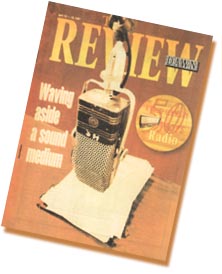
Search the Republic of Rumi |
|
DAWN Tuesday Review, April 10-16, 1997 " Peshawar Radio Station is the oldest in Pakistan and there is an interesting story about how it came about. When Sardar Abdul Qayyum Khan, the renowned political leader of N.W.F.P. went to London during the Round Table Conference (early ‘30s) he became fascinated by the radio, which had started operating in Britain about a decade ago. He personally met Marconi, the genius who had invented the machine, and requested him to donate one for the N.W.F.P.. Marconi promised to do so. Meanwhile, the British government set up a 20 KW transmitter in Delhi, which started working from 1st January 1936. Soon after the gift from Marconi arrived. This transmitter, personally engineered by Marconi himself, was installed in Peshawar and inaugurated by Rallop Griffith, the Governor. Sardar Qayyum had also received about 30 receiving sets from his friend. They were placed in the hujras of great Khans in the region, where the locals could gather in the evenings and listen to the broadcast – songs, news and propaganda plays. The clergy did not take much time in responding to it. “The receiving sets are actually two-way devices to carry the conversations of the Khans to the British rulers”, they suspected. “Radio is a devil’s instrument, and anybody who broadcasts azan from it is a kafir and guilty of rank sacrilege.” The first station in-charge was Muhammad Aslam Khattak, an educated young man from an influential family. He had a talent for drama. Sajjad Sarwar Niazi, who later made a name in music, (and is also the father of famous singers Naheed Niazi and Najma Niazi) was the first director. One of the famous plays from those days was The Bloody Cup, written by Aslam Khattak in English and translated into Pashto for the raido. It was the story of a young man who gets drunk, commits murder and is hanged. The moral of the story was to always remain in your senses and avoid the gallows – murder and execution was becoming very common in the N.W.F.P. in those days. The play became so popular that one day, as some people were listening to it and others talking amongst themselves, a quarrel erupted because of the play and four or five people were killed in the brawl. The radio station was shifted to a new building with 10 KW transmitter on 16th July 1942. The long history of Peshawar Radio is filled with many famous names who were associated with it. Kaifi Dev, Ahmed Nadeem Qasmi, Mohsin Ehsan, Khatir Ghaznawi, Farigh Bukhari among others. Perhaps the most famous programme has been Hujra (1942 through 1982), originally written by Samandar Khan Samandar with occasional pieces from Syed Rasool Rasa and Ajmal Khattak. It was produced by Qazi Ahmed Ali and later, Qazi Ahmed Saeed, while the cast included Shehzad Khan, Abdullah Khan Maghmum, Gul Muhammad Khan Gul, Raheem Shah Naseem. Equally popular was Qahwakhana, which originated in 1945 in Urdu (it received inputs from Ahmed Nadeem Qasmi also) and later transferred to Hindko in 1960. Marconi’s transmitter was still in operation until a few years back. Let’s hope somebody will think of preserving this relic of historical importance. |
This brief writer-up appeared in an issue of Tuesday Review celebrating the 50 years of radio in Pakistan. |
||
